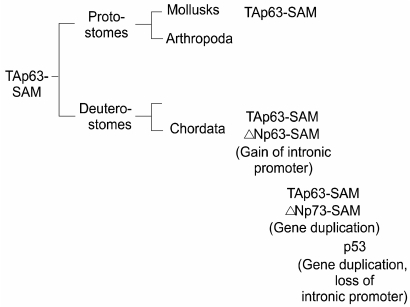Fig. 5.
Evolution of the p53 family. The evolution of the p53 family is presented based on incomplete data from genome analysis efforts. Significantly, the original member of the family, TA-p63-SAM, is also the most conserved. For instance, after the major bifurcation of the animal kingdom to protostomes and deuterostomes, TA-p63-SAM is found in both arms including mollusks and chordates. It is in chordates, however, where the majority of developments in the family occur, including the gain of the DN promoter in p63, the duplication of this gene to give rise to p73, and the duplication of the p73 gene to give rise to p53. This latter duplication apparently fails to maintain the internal, DN promoter in the p53 gene. Interestingly, the appearance of p53 in vertebrates is indistinguishable in time from that of p73 and the DN- isoforms of p63, suggesting the possibility that they co- evolved due to some functional requirement.

